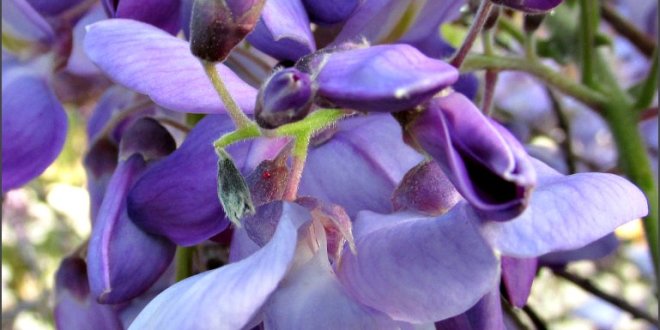Wisteria is a beautiful spring vine. Because of my visits to the California Spanish missions, I cannot think of Wisteria without thinking of California.
Back in 2014, I planted my wisteria in probably the worst spot for it in my garden: a spot nestled in an east-facing corner that only gets a few hours of sunlight per day. All of the good sunny spots are already claimed. After two years, the vines reached the 8-foot high wall and now I am training them to run along that wall and also up the taller A-frame portion of the house. After five years, the vine started blooming.
Details
Family: Papilionaceae (pa-pil-ee-uh-NAY-see-ee) (Info)
Genus: Wisteria (wis-TEER-ee-uh) (Info)
Species: frutescens (froo-TESS-enz) (Info)
Synonym:Wisteria frutescens var. macrostachya
Synonym:Wisteria macrostachya
Category: Shrubs
Height:
8-10 ft. (2.4-3 m)
10-12 ft. (3-3.6 m)
12-15 ft. (3.6-4.7 m)
15-20 ft. (4.7-6 m)
Spacing:
6-8 ft. (1.8-2.4 m)
8-10 ft. (2.4-3 m)
10-12 ft. (3-3.6 m)
Hardiness:
USDA Zone 6a: to -23.3 °C (-10 °F)
USDA Zone 6b: to -20.5 °C (-5 °F)
USDA Zone 7a: to -17.7 °C (0 °F)
USDA Zone 7b: to -14.9 °C (5 °F)
USDA Zone 8a: to -12.2 °C (10 °F)
USDA Zone 8b: to -9.4 °C (15 °F)
USDA Zone 9a: to -6.6 °C (20 °F)
USDA Zone 9b: to -3.8 °C (25 °F)
Sun Exposure: Sun to Partial Shade
Danger: Seed is poisonous if ingested; All parts of plant are poisonous if ingested
Bloom Color: Blue-Violet; Violet/Lavender
Bloom Time: Mid Spring
Foliage: Deciduous; Smooth-Textured
Other details: This plant is suitable for growing indoors
Average Water Needs; Water regularly; do not overwater
Soil pH requirements: 6.1 to 6.5 (mildly acidic); 6.6 to 7.5 (neutral)
Patent Information: Non-patented
Propagation Methods: By dividing the rootball
Seed Collecting:
Allow pods to dry on plant; break open to collect seeds
Seed does not store well; sow as soon as possible
Read more: http://davesgarden.com/guides/pf/go/1351/#ixzz3GZ2jvdKW








